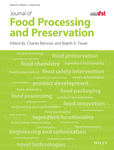Structural and physicochemical properties of resistant starch from Chinese chestnut (Castanea mollissima) prepared by autoclaving treatment and pullulanase hydrolysis
Funding information: Fundamental Research Funds for Central University, Grant/Award Number: 2015ZCQ-SW-04; China Forestry Public Welfare Industry Professional Research Program, Grant/Award Number: 201204401
The English in this document has been checked by at least two professional editors, both native speakers of English. For a certificate, please see: http://www.textcheck.com/certificate/GyMQQj.
Abstract
The purpose of this study was to evaluate the properties of resistant starch (RS) from Chinese chestnut (Castanea mollissima), which was prepared by autoclaving treatment and pullulanase hydrolysis. Scanning electron microscopy (SEM) revealed that the chestnut resistant starch (CRS) granules had a cohesive structure, an irregular shape, and diameters ranging from 6.0 to 7.2 µm. The enzymatic and retrogradation processes increased the yield of RS, and also decreased its swelling power, water solubility, and viscosity. An increase in transparency was also observed. The percent syneresis of the two starches increased steadily over time. X-ray diffraction (XRD) analyses revealed that autoclaving and pullulanase hydrolysis converted C-type native starch into a B-type pattern and increased the crystallinity. In addition, differential scanning calorimetry (DSC) results indicated a reduction in gelatinization temperature and enthalpy compared with native starch. The thermal properties of RS increased due to the retrogradation and recrystallization (p < .05).
Practical applications
Chinese chestnut (Castanea mollissima) is an important nut crop with high nutrition and planted in China widely. High water content in fresh chestnut leads to mildew attack easily, which will affect the chestnut market value and trade business. Therefore, it has great significance and practical demand to develop the deep processing technology and diversify its products. The resistant starch has been implemented as an ingredient for its resistant digestion properties for making flour food and functional food. However, the research and application of resistant starch from Chinese chestnut (Castanea mollissima) has been rarely seen. This study investigated the structural and physicochemical properties of chestnut resistant starch and provided a reference for the application of chestnut resistant starch in the food processing industries. For example, an increase in transparency and syneresis suggested chestnut resistant starch could be potentially used as a functional ingredient in jelly, beverages, and other food products, but not be possible for use in the frozen food industry.




